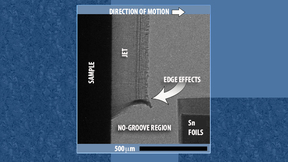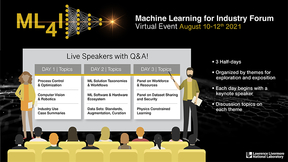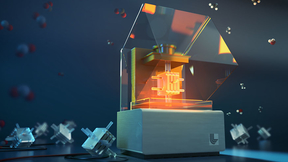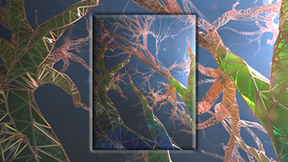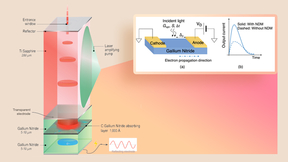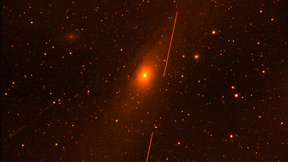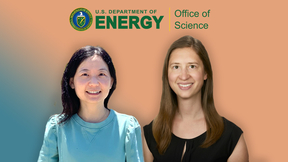Back
Engineering
Manufacturing Day webinar highlights industry collaboration, emerging technologies
To celebrate Manufacturing Day 2021, the High Performance Computing for Energy Innovation (HPC4EI) initiative will hold a special webinar on Oct. 1 featuring speakers from the Department of Energy (DOE), presentations by DOE scientists and students and virtual tours. The free event runs from 7:30 a.m. to 12:30 p.m. PDT and is open to all. The webinar’s plenary session…
Lawrence Livermore-led effort one of nine DOE-funded data reduction projects
A Lawrence Livermore National Laboratory-led effort in data compression was one of nine projects recently funded by the U.S. Department of Energy (DOE) for research aimed at shrinking the amount of data needed to advance scientific discovery. LLNL was among five DOE national laboratories to receive awards totaling $13.7 million for data reduction in scientific applications…
LLNL, other Bay Area labs to host webinar about business partnerships, the future of semiconductors
Lawrence Livermore National Laboratory (LLNL) and its three partner national labs in the Bay Area Lab Innovation Networking Center (LINC) will offer a webinar about the future of semiconductors and advanced materials on Wednesday, Aug. 25. The two-hour virtual Zoom webinar, called “Over the Horizon” and set to start at noon Pacific time, is primarily targeted at Bay Area…
Lawrence Livermore recognizes latest graduates of Machinist Apprentice Program
Zach Dunn has always enjoyed working on cars and building things with his hands. Deciding a four-year college wasn’t for him, he pursued the trades as a machinist, joining Lawrence Livermore National Laboratory’s prestigious Machinist Apprentice Program in 2017 right out of high school. On July 29, Dunn became one of five recent graduates of the program for 2020 and 2021…
LLNL hosts Test Site Verification Team orientation
Lawrence Livermore National Laboratory (LLNL) hosted an in-person orientation meeting recently for members of the National Nuclear Security Administration’s (NNSA) Test Site Verification Team (TSVT). TSVT is sponsored by NNSA’s Office of Nuclear Verification (ONV) Nuclear Compliance Verification (NCV) Program. The TSVT is led by Kim Knight from LLNL and Emily Schultz…
LLNL optimizes flow-through electrodes for electrochemical reactors with 3D printing
To take advantage of the growing abundance and cheaper costs of renewable energy, Lawrence Livermore National Laboratory (LLNL) scientists and engineers are 3D printing flow-through electrodes (FTEs), core components of electrochemical reactors used for converting CO2 and other molecules to useful products. As described in a paper published by the Proceedings of the…
Scientists use radiography to understand the evolution of liquid and solid microjets
Lawrence Livermore National Laboratory (LLNL) scientists have experimentally tested the predictions of a 2020 study that computationally investigated the effect of melting on shock driven metal microjets. That earlier work predicted that melting the base material does not necessarily lead to a substantial increase in jet mass. The LLNL team confirmed the predictions of…
LLNL and KCNSC team up to accelerate design-to-deployment with new polymer production enclave
A polymer production enclave, in partnership with the Kansas City National Security Campus (KCNSC) and Lawrence Livermore National Laboratory (LLNL), is on budget and on schedule to bring modern technology into the Nuclear Security Enterprise. The enclave will enable rapid development of design and production processes of polymer parts for modernization programs. This…
LLNL and KCNSC team up to accelerate design-to-deployment with new polymer production enclave
A polymer production enclave, in partnership with the Kansas City National Security Campus (KCNSC) and Lawrence Livermore National Laboratory (LLNL), is on budget and on schedule to bring modern technology into the Nuclear Security Enterprise. The enclave will enable rapid development of design and production processes of polymer parts for modernization programs. This…
Registrations ongoing for virtual forum on industrial machine learning applications
Registration is open through July 29 for the first-ever Machine Learning for Industry Forum (ML4I), a three-day virtual event starting Aug. 10. The forum aims to foster and illustrate the adoption of machine learning methods for practical industrial outcomes, with a strong emphasis on manufacturing. Over the course of the event, attendees will engage in dialog about…
LLNL and collaborators improve electrochemical reactor performance through 3D printing
Lawrence Livermore National Laboratory (LLNL) scientists and their collaborators are leveraging the power of 3D printing to improve the performance of electrochemical reactors used to convert carbon dioxide (CO2) to useful energy sources, chemicals and material feedstocks. Working under a cooperative research and development agreement (CRADA) with Stanford University and…
It’s no drag: New heavy vehicle design increases fuel efficiency, cuts carbon emissions
Reshaping the exterior of heavy vehicles, such as semitrucks, so that they are aerodynamically integrated along their entire length in a smooth, continuous fashion could reduce drag, increase fuel efficiency and cut carbon emissions. Using wind tunnel measurements and computational fluid dynamics simulations, Lawrence Livermore National Laboratory (LLNL) engineers have…
Taking cues from nature, breakthrough ‘cellular fluidics’ technology could have sweeping impacts
Inspired by the way plants absorb and distribute water and nutrients, Lawrence Livermore National Laboratory (LLNL) researchers have developed a groundbreaking method for transporting liquids and gases using 3D-printed lattice design and capillary action phenomena. In a paper published today in Nature and featured on the publication’s cover, LLNL researchers describe 3D…
Lawrence Livermore team designs semiconductor switch for next-generation communications
Lawrence Livermore National Laboratory (LLNL) engineers have designed a new kind of laser-driven semiconductor switch that can theoretically achieve higher speeds at higher voltages than existing photoconductive devices. The development of such a device could enable next-generation satellite communication systems capable of transferring more data at a faster rate, and over…
LLNL/Tyvak space telescope goes into orbit
Thousands of images of Earth and space have been taken by a compact space imaging payload developed by Lawrence Livermore National Laboratory (LLNL) researchers and its collaborator Tyvak Nano-Satellite Systems. Known as GEOStare2, the payload has two space telescopes that together have taken more than 4,500 pictures for space domain awareness, astronomy and Earth…
Army reservists a vital part of Lab’s workforce
Lawrence Livermore National Laboratory (LLNL) joins in the celebration of the U.S. Army birthday on June 14. Created in 1775, the army originally consisted of volunteer soldiers with roots to the Continental Army — and was formed to fight the Revolutionary War. Today, as the largest branch of the country’s military, the proud men and women of the U.S. Army continue to…
Machine learning aids in materials design
A long-held goal by chemists across many industries, including energy, pharmaceuticals, energetics, food additives and organic semiconductors, is to imagine the chemical structure of a new molecule and be able to predict how it will function for a desired application. In practice, this vision is difficult, often requiring extensive laboratory work to synthesize, isolate,…
DOE honors Schmidt and Zheng, two early career Lab scientists
Two scientists from Lawrence Livermore National Laboratory (LLNL) are recipients of the 2021 Department of Energy’s (DOE) Office of Science Early Career Research Program award. Andrea Schmidt and Xue Zheng are among 83 scientists nationwide selected for the recognition. Under the program, typical awards for DOE national laboratory staff are $500,000 per year for five years…
LLNL-patented power grid technology could reduce global CO2 emissions by 10 percent or more
To address inefficiencies in transmitting electricity over smart grids, engineers at Lawrence Livermore National Laboratory (LLNL) and their collaborators have developed a light-activated switch that, if fully deployed, could reduce carbon emissions by more than 10 percent. Capable of sending high-voltage, direct-current power along grid lines and switching high voltages…
LLNL-developed thin-film electrodes reveal key insight into human brain activity
Thin-film electrodes developed at Lawrence Livermore National Laboratory (LLNL) have been used in human patients at the University of California, San Francisco (UCSF), generating never-before-seen recordings of brain activity in the hippocampus, a region responsible for memory and other cognitive functions. In a study published today in the journal Nature Communications,…








